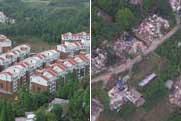China
Full text: China´s Actions for Disaster Prevention and Reduction
V. Public Participation in Disaster Reduction
The Chinese government regards it important to give full play to the role of the public in disaster prevention and reduction, and supports and promotes wide public participation in such work by making people more aware and capable of disaster prevention and reduction. The Chinese government timely releases information on disaster situations and demands from disaster-hit areas. It has strengthened its guidance, standardized management and provided guarantee services. Meanwhile, it is making continuous efforts to improve its social mobilization mechanism, and integrate resources from both government and society to form a disaster relief pattern in which they will complement each other with their respective strengths. People of all walks of life are actively involved in disaster relief efforts whenever there is a big natural disaster. Compatriots from Hong Kong, Macao and Taiwan as well as overseas Chinese and foreigners of Chinese origin all provide aid and donations to disaster-hit areas in China. During the devastating Wenchuan earthquake of 2008, China received nearly 76 billion yuan-worth of donations and relief materials from both in and outside China. Personalized services such as psychological help from the public have also been effective in building the confidence of people in disaster-stricken areas.
Charities play a key role in disaster relief, and the government has adopted measures to support their development. In terms of the preferential taxation system that encourages public donations, the Enterprise Income Tax Law of the People's Republic of China, which became effective in January 2008, stipulates that the portion of expenses for charitable donations by enterprises is unified to within 12 percent of the total annual profit and it is to be deducted from the taxable income, instead of the 3 percent as was the practice before. After the Wenchuan earthquake, the government stipulated that donations from enterprises and individuals made through public welfare organizations, people's governments and their departments at or above the county level to disaster-hit areas can be totally deducted from the enterprises' and individuals' taxable income for the year. In December 2008, the government department concerned issued a notice detailing the scope of public welfare undertakings managing public welfare donations, the qualification of tax-free donations from public welfare organizations, and the authorization and procedures for certifying such qualifications. The state encourages the normal development of foundations. By the end of 2008, there were 1,531 foundations of various kinds in China, 162 more than in the previous year. In recent years, the government has been helping charity organizations to enhance their reputation, and promoting annual checkups and evaluations of such foundations.
The Chinese government is very supportive of making public donations a part of daily and social life, encouraging and guiding volunteers to take part in disaster prevention and reduction work. In recent years, public donations on a voluntary basis have become more regular and popular among general public across China. By the end of 2008, 34,000 public donation stations and charity venues in supermarkets had been established in China’s large and medium-sized cities as well as in small cities with adequate conditions, preliminarily forming a regular national donation service network. The number of disaster reduction volunteers has increased rapidly with the continued progress in China’s modernization and the improvement of people’s living standard. By the end of last year, there were 430,000 community volunteer organizations, comprising nearly 100 million volunteers, among whom those belonging to the three major organizations - the Communist Youth League, Red Cross and civil administration - registered an increase of 14.72 million over 2007, an increase of 31.8 percent. After the Wenchuan earthquake, Chinese people, enterprises and social organizations were actively involved in related emergency relief work, with over three million volunteers from both in and outside China working in the quake-hit areas and more than 10 million volunteers participating in relief work in the rest of the country.
The Chinese government has made a point of conducting publicity and educational work for disaster prevention and reduction, organizing a rich variety of related activities on International Day for Natural Disaster Reduction each October. Government departments concerned and local governments have set up special bulletin boards focusing on disaster reduction in public venues. They also run special programs and columns for this purpose in newspapers and magazines, and on radio and TV, and in portal websites of the Internet, make advertisements to teach people the practical skills to avoid and cope with disasters.
Disaster prevention and reduction classes are offered in elementary and secondary schools, and many kinds of emergency response exercises are held. A series of related publicity and educational products have also been developed, including popular science readings, wall posters, audio-visual publications and case-study teaching materials. The Red Cross and other non-governmental organizations are playing a key role in raising the public’s awareness and capability for disaster prevention and reduction by taking vigorous measures to conduct emergency aid training and to popularize related knowledge and skills.
The state pays special attention to policy studies and pilot work concerning the insurance industry’s role in disaster prevention and reduction. Efforts are made continuously to sum up the experience of and improve the risk prevention and relief mechanism for agriculture and forestry, which combine natural-disaster insurance and state financial subsidies. Efforts are also being made to set up an overall mechanism to disperse the risks of disasters in the areas of agriculture and forestry, and to gradually enhance the ability of the insurance industry to effectively cover the economic loss and damage inflicted by natural disasters.



